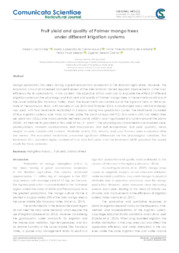Fruit yield and quality of Palmer mango trees under different irrigation systems.
Fruit yield and quality of Palmer mango trees under different irrigation systems.
Author(s): SIMOES, W. L.; MOUCO, M. A. do C.; ANDRADE, V. P. M. de; BEZERRA, P. P.; COELHO, E. F.
Summary: Mango production has been having a great economical expression in the Brazilian agriculture. However, the economic crisis and increased competitiveness of the international market required improvements in the crop efficiency for its sustainability. In this context, the objective of this work was to evaluate the effect of different irrigation system on the physiology and fruit yield and quality of Palmer mango trees in the semiarid conditions of the Lower Middle São Francisco Valley, Brazil. The experiment was carried out at the Agranvil Farm, in Petrolina, state of Pernambuco, Brazil, with harvests in July 2013 and October 2014. A randomized block statistical design was used, with four treatments replicated in 5 blocks, during two production cycles. The treatments consisted of four irrigation systems: one micro sprinkler under the plant canopy (MSPC); drip system with two lateral lines per plant row (DSLL); one micro sprinkler between plants (MSBP); and ring-shaped drip system around the plants (RSDS). All treatments provided a flow rate of 56 L h-1 plant-1. The physiological characteristics evaluated were: photosynthesis, stomatal conductance, leaf transpiration, and leaf temperature. Fruit yield, quantity, mean weight, volume, soluble solid content, titratable acidity (TA), density, and pulp firmness were evaluated after the harvest. The evaluated treatments presented significant differences for the physiological variables. The treatment DSLL provided higher number of fruits and fruit yield, and the treatment MSBP provided the lowest results for these variables.
Publication year: 2020
Types of publication: Journal article
Unit: Embrapa Semi-arid Region
Observation
Some of Embrapa's publications are published as ePub files. To read them, use or download one of the following free software options to your computer or mobile device. Android: Google Play Books; IOS: iBooks; Windows and Linux: Calibre.
Access other publications
Access the Agricultural Research Database (BDPA) to consult Embrapa's full library collection and records.
Visit Embrapa Bookstore to purchase books and other publications sold by Embrapa.

